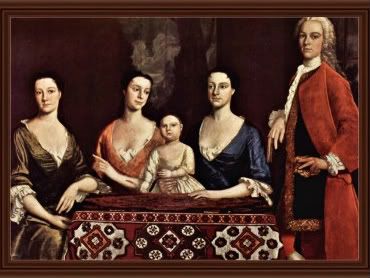Colonial Historical Theme Week Begins Today! Tada!!!!!
Yes, today we begin to talk about the colonial period and, of course, how that relates to our dolls. Obviously, the so-called "Colonial Period" has a lot of different dates throughout the country as there were several countries that owned colonies throughout North America: Spain, France, the Netherlands, Sweden, Russia, etc. etc.
But Felicity Merriman (our main AG protagonist during this time period) lived in Williamsburg, Virginia, which was an English colony. The Eastern seaboard was (in general) colonized by the English from the early 1600s until 1776 when the 13 colonies declared their independence from the British crown.
So from the early 1600s to 1776 life in America changed quite a bit. We go from the strict lifestyle of the pilgrims to the more comfortable lifestyle the Merriman family enjoyed. Felicity and Elizabeth's stories date around 1774, right on the cusp of The Revolutionary War. Our colonial doll, Mary Royall, had her portrait painted with her sister Elizabeth by John Singleton Copley around 1758--- long before the notorious Townshend Acts of 1767 and the Tea Act of 1773. These were two Parliamentary actions designed to create more money for England by draining the colonies of moola.
At the time Mary's portrait was painted, she was what we would call a "tween." But she wasn't too young to be betrothed or promised in marriage to her future husband. Hence, the painting below (which I have showed here before, so sorry if you've seen it already) served as an example of how well-bred the young ladies were and how they were very suitable for marriage. By the time of Felicity's stories in 1774, Mary and Elizabeth would have been married and probably would have had several children already. In the colonial period young girls had to grow up very fast in comparison to our culture.
For today's pictures we wanted to show you the MyAG #41 that is in our Fall 2010 Doll Giveaway. She is pretending to be Elizabeth Royall, Mary's sister. Some day we will buy another #41 to be our Elizabeth. But we will probably wait to do that in an AG store. So in the photos below you see her in a burgundy calico dress handmade by Etsy seller Terristouch. It is a really lovely frock that is actually made from a fabric very much like one Penny's mother used for doll clothing and dollhouse furniture a long time ago.
#41 is standing by Felicity's table and chair with her Tea Set we purchased from AG. Even though it is pink (my gosh!) it does look very nice set out on the table. It comes with a teapot, creamer, sugar-pot, two cups, two saucers, two spoons, a "silver" tray, and a tea box. It is pretty posh. We would have preferred that AG make a full set like this of the original blue tea cup pattern for Felicity (which is also illustrated in her books)... but alas, AG does like to use pink....
Mary and Elizabeth Royall were the daughters of Isaac Royall, Jr. of Medford, Massachusetts. He was one of the wealthiest merchants in that colony and hence everything about the above portrait is designed to convey the wealth and status of the Royall family. Isaac Sr. had made the family's wealth from sugar cane plantations in Antigua and his extensive participation in the so-called "Triangle Trade"-- slaves, rum, and sugar being moved around the Atlantic. Though Isaac Sr. had several children with his wife, Elizabeth Brown, only two of them lived into adulthood: Isaac Jr. and Penelope.
In 1732 Isaac Sr. decided to pull up roots from Antigua and move his family to Massachusetts. Yellow fever outbreaks, drought, and slave uprisings had made life on the island too harsh for him. He planned on retiring to the colonies on a 600 acre estate in Medford. In 1737 the Royalls and 27 of their slaves arrived in Boston. Though there were already slaves in Massachusetts, most families did not own 27. Their subsequent arrival in Medford doubled the number of slaves in that town.
Below is a portrait by Robert Feke of Isaac Jr. with his mother, sister, wife and child in Boston in 1741, two years after his father had passed away. Isaac Jr. had married Elizabeth McIntosh in 1738. They had three daughters, one of whom died at seven years old. The other two were of course Mary and Elizabeth.
While Mary's history is a little vague, we do know that Elizabeth married the younger Sir William Pepperrell, had several children, and died quite young in Boston in 1776. Below you can see her in another painting by John Singleton Copley with her husband and children, painted in 1778. Obviously at this point William is a widower and this image is a sentimental look at what life could have been like if Elizabeth were still alive.
In our next colonial post we will talk further about the Royall family, their lifestyle, their history during the Revolutionary War, and more! We'll also be showing you more colonial handmade doll clothing of course. Stay tuned for more interesting stuff!





2 comments:
That dress is gorgeous! I love the way it looks on #41. *sigh* I want that doll more each time I look at a new picture of her.
Thanks so much for the fun history lesson and the pics. Looking forward to the next installment. And I agree with Sophie...#41 is beautiful! :)
Post a Comment